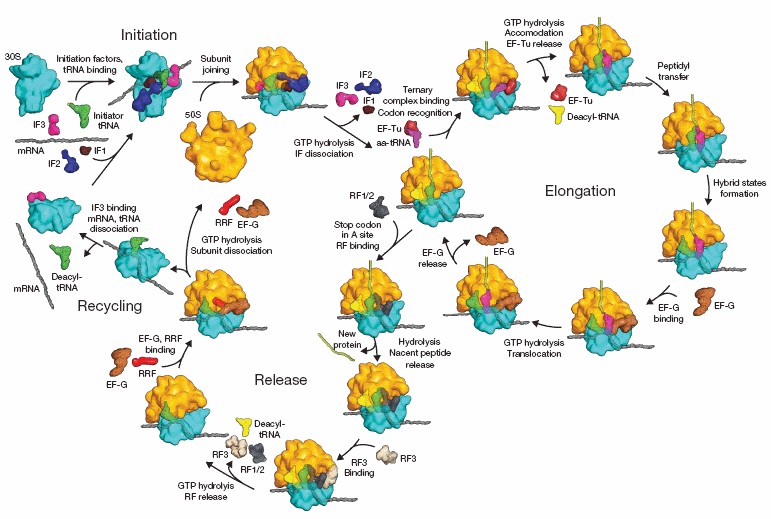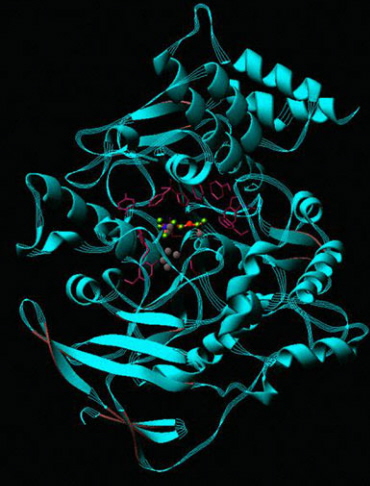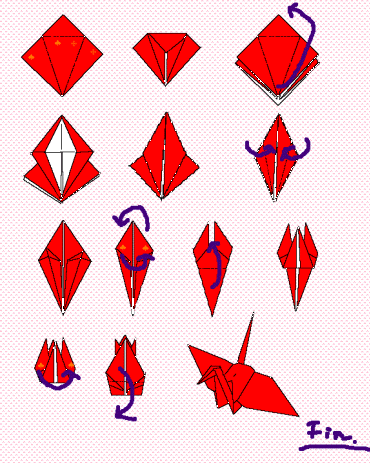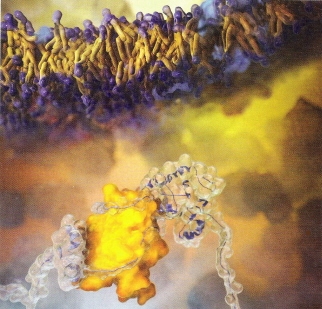The difference between this and the function of a cell is mindboggling.
Mindboggling complexity - proteins
Even a single cell is not simple. In Darwin's day researchers looked at cells under the microscope and saw little balloons filled with goo they called protoplasm, so they thought cells were simple forms of life. 150 years later we know that there are many types of cells, and each cell is a little city at work. The smallest known genome (Mycoplasma genitalium) has 482 genes. 18 The minimum possible for an organism to survive is probably 200 to 300 genes. Most bacteria have 1000 to 4000 genes. A popular textbook on the cell 1 is 1600 pages long and weighs 7 pounds. Everything about the cell is stunningly complex. Plants and animals contain a great variety of cells. The human body has about 210 different types of cells.
Cells are made of proteins, and everything that goes on in a creature involves proteins intchemical reqeracting with each other. Proteins are generally 50 to 2000 amino acids long; a typical one has about 300 amino acids. 1 Ribosomes are molecular machines that build proteins in cells, using messenger RNA as the template. Here is an overview of how a bacterial ribosome "translates" RNA into protein. Every protein in bacteria is made this way.

From: Schmeing, T. Martin, V. Ramakrishnan. 29 October 2009. What recent ribosome structures have revealed about the mechanism of translation. Nature, Vol. 461, pp. 1234-1242.
A protein is not just a long ribbon of amino acids strung together from the DNA pattern. It folds itself into a 3D structure.


Diagram of a folded protein |
Origami |
The temperature and chemical concentrations must be right for it to fold correctly, and many proteins get help from special proteins called "molecular chaperones". Chaperones can keep proteins separated from each other while they are folding, prevent mistakes in folding, and even unfold mistakes to give the protein a second chance to get it right. After helping one protein fold, a chaperone will go help another one fold.

" A chaperone protein (bottom, yellow) called SecB guides the folding of another protein (transparent)
in this artist's illustration." --Science News, December 1, 2007, Vol. 172, p. 342
Making and folding proteins goes on continuously throughout the body. Misfolding can lead to more than proteins that don't work. In humans, bunches of them (aggregates) can lead to diseases such as Alzheimer's, Huntington's, or sickle cell. "Proteins are so precisely built that the change of even a few atoms in one amino acid can sometimes disrupt the structure of the whole molecule so severely that all function is lost." 1 All proteins stick (bind) to other molecules. But each can bind to only a few of the thousands it encounters. "An average protein in a human cell may interact with somewhere between 5 and 15 different partners." 1 Their shapes fit each other like a hand in a glove. "Proteins can form enormously sophisticated chemical devices." "The most impressive tasks are carried out by large protein assemblies formed from many protein molecules." "Each of the central processes in a cell... is catalyzed by a highly coordinated, linked set of 10 or more proteins." 1 The parts of a cell where proteins are made (ribosomes) are themselves made of many different proteins. "The complexity of living organisms is staggering." 1 In the face of this breathtaking complexity, evolutionists have tried to find the basic things necessary for a cell to function. So far they have found 17 general categories 1 :
- Replication, recombination, and repair
- Transcription
- Cell cycle control, mitosis, and meiosis
- Defense mechanisms
- Cell wall/membrane biogenesis
- Signal transduction mechanisms
- Intracellular trafficking and secretion
- Translation
- Post-translational modification, protein turnover, chaperones
- Energy production and conversion
- Carbohydrate transport and metabolism
- Amino acid transport and metabolism
- Nucleotide transport and metabolism
- Coenzyme transport and metabolism
- Lipid transport and metabolism
- Inorganic ion transport and metabolism
- Secondary metabolite biosynthesis, transport, and catabolism
Each category requires many proteins. All have to be in place and working together or the cell is wrecked.
So evolutionists have to believe that for each protein, pure chance laid out long strings of amino acids that fold themselves into the exact shapes needed to interact with other specialized proteins and, where needed, get help from chaperone proteins which themselves appeared by chance. The necessary proteins cannot be invented one at a time. Either they are all there, ready to work together, or nothing happens and they disintegrate. Yet even if it could design proteins, mutation-natural selection would only work on one at a time sporadically over many years. Considering just the complexity of proteins, the notion of creating them with mutation-natural selection is as silly as asking someone to build a television set with a spoon and a toothbrush. If Darwin had known what we have learned about proteins, he probably would have abandoned the theory of evolution.



